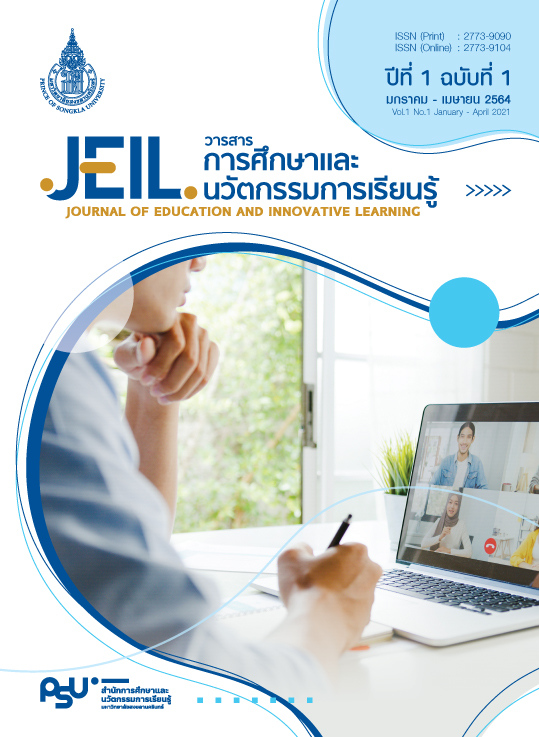การพัฒนารูปแบบการเรียนโดยใช้เทคโนโลยีเสมือนจริงในสภาพแวดล้อมการเรียนแบบยูบิควิตัส เพื่อส่งเสริมความคิดสร้างสรรค์ด้านศิลปะอิสลาม
Main Article Content
บทคัดย่อ
การวิจัยในครั้งนี้มีวัตถุประสงค์ 1) เพื่อพัฒนารูปแบบการเรียนโดยใช้เทคโนโลยีเสมือนจริงในสภาพแวดล้อมการเรียนแบบยูบิควิตัสเพื่อส่งเสริมความคิดสร้างสรรค์ด้านศิลปะอิสลาม 2) เพื่อประเมินความคิดสร้างสรรค์ด้านศิลปะอิสลามของนักศึกษาที่เรียนโดยใช้รูปแบบการเรียนโดยใช้เทคโนโลยีเสมือนจริงในสภาพแวดล้อมการเรียนแบบยูบิควิตัส และ 3) เพื่อศึกษาความพึงพอใจของผู้เรียนด้วยรูปแบบการเรียนโดยใช้เทคโนโลยีเสมือนจริงในสภาพแวดล้อมทางการเรียนแบบยูบิควิตัส เพื่อส่งเสริมความคิดสร้างสรรค์ด้านศิลปะอิสลาม โดยมีกลุ่มตัวอย่างที่ใช้ในการวิจัยคือ นักศึกษาปริญญาตรี คณะศึกษาศาสตร์ มหาวิทยาลัยสงขลานครินทร์ จำนวน 78 คน
ผลการวิจัยพบว่า:
1) องค์ประกอบของการพัฒนารูปแบบการเรียนโดยใช้เทคโนโลยีเสมือนจริงในสภาพแวดล้อมแบบยูบิควิตัส เพื่อส่งเสริมความคิดสร้างสรรค์ด้านศิลปะอิสลาม ประกอบด้วย 4 องค์ประกอบ ได้แก่ (1) เครื่องมือจัดการเรียนการสอนคือ เทคโนโลยีเสมือนจริง (2) ด้านเนื้อหาบทเรียน เรื่องศิลปะอิสลาม (3) ด้านการจัดการเรียนรู้ในสภาพแวดล้อมแบบยูบิควิตัส ประกอบด้วยสภาพแวดล้อมการเรียนรู้แบบยูบิควิตัส และการเรียนการสอนแบบวัฎจักรการเรียนรู้ 5E และ (4) ด้านการวัดและประเมินผล ประกอบด้วยการวัดความคิดสร้างสรรค์ของผู้เรียนและประเมินความพึงพอใจของผู้เรียนต่อรูปแบบการเรียนโดยใช้เทคโนโลยีเสมือนจริงในสภาพแวดล้อมแบบยูบิควิตัสฯ อยู่ระดับเหมาะสมมาก
2) ความคิดสร้างสรรค์ด้านศิลปะอิสลามของผู้เรียนโดยใช้เทคโนโลยีเสมือนจริงในสภาพแวดล้อมการเรียนแบบยูบิควิตัสฯ หลังเรียนสูงกว่าก่อนเรียนอย่างมีนัยสำคัญทางสถิติที่ระดับ .05
3) คุณภาพด้านเนื้อหาและสื่อการเรียนการสอนอยู่ในระดับมาก
4) ความพึงพอใจของผู้เรียนที่มีต่อรูปแบบการเรียนด้วยเทคโนโลยีเสมือนจริง อยู่ในระดับพึงพอใจมาก
Article Details

อนุญาตภายใต้เงื่อนไข Creative Commons Attribution-NonCommercial-NoDerivatives 4.0 International License.
เนื้อหาและข้อมูลในบทความที่ตีพิมพ์ในวารสารการศึกษาและนวัตกรรมการเรียนรู้ ถือเป็นข้อคิดเห็นและความรับผิดชอบของผู้เขียน ซึ่งกองบรรณาธิการวารสาร ไม่จำเป็นต้องเห็นด้วยหรือร่วมรับผิดชอบใด ๆ และไม่สงวนสิทธิ์การคัดลอกบทความเพื่อใช้ประโยชน์ทางวิชาการ แต่ให้อ้างอิงข้อมูลแสดงที่มาของบทความทุกครั้งที่นำไปใช้ประโยชน์
เอกสารอ้างอิง
Azuma, R., Baillot, Y., Behringer, R., Feiner, S., Julier, S., & MacIntyre, B. (2001). Recent advances in augmented reality. IEEE Computer graphics and applications, 21(6), 34–47.
Di Serio, Á., Ibáñez, M. B., & Kloos, C. D. (2013). Impact of an augmented reality system on students’ motivation for a visual art course. Computers & Education, 586-596.
Jedaman, P., Kitrakan, P., Pimdee, P., Wangsaard, K., Sukkamart, A., & Sooksup., C. (2016). Strategies to Management towards the 21st Century Transformation: Thailand 4.0. Journal of Curriculum and Instruction, Faculty of Education, 2(1), 1-14. [in Thai]
Munoz-Cristobal, J. A., Jorrin-Abellan, I. M., Asensio-Perez, J. I., Martinez-Mones, A., Prieto, L. P., & Dimitriadis, Y. (2015). Supporting teacher orchestration inubiquitous learning environments: A study in primary education. Learning Technologies, IEEE Transactions on Learning, 8(1), 83-97
Nimnual, R. (2011). Collaborative learning online for packaging design using virtual reality and knowledge management. (Doctoral dissertation). King Mongkut’s University of Technology Thonburi, Bangkok. [in Thai]
Panmanee, A. (1997). Creativity. Bangkok: Ton-OR Grammy. [in Thai]
Sanabria J., & Arámburo-Lizárraga J. (2016). Enhancing 21st Century Skills with AR: Using the Gradual Immersion Method to develop Collaborative Creativity. EURASIA Journal of Mathematics Science and Technology Education, 13(2). 487-501
Tansiri, P. (2010). instructional package together with Augmented Reality. Executive Journal, 28(2), 169-175. [in Thai]
Yahya, S., Ahmad, E., & Jalil, K. (2010). The definition and characteristics of ubiquitous learning: A discussion. International journal of education and development using information and communication technology, 6(1), 117-127


